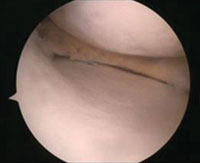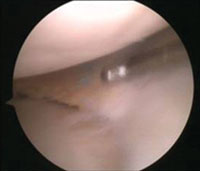Meniscal replacement shows promise for managing meniscectomy’s downsides
No meniscal implants are FDA approved, but an arthroscopy specialist described the benefits of these devices.
 Peter R. Kurzweil |
SAN DIEGO — Preserving as much of the meniscus as possible following a tear or partial meniscectomy has been associated with normalizing the knee because even a small amount of remaining tissue will cushion the joint and keep other knee problems from developing. However, current meniscal treatment options are extremely limited, according to an orthopedic surgeon from Long Beach, Calif.
Peter R. Kurzweil, MD, said at the 2011 Arthroscopy Association of North America Specialty Day Meeting, “The main goal of meniscus replacement … is to re-establish the force and load transmission, which will prevent arthritis that frequently develops after meniscectomy.”
He discussed two off-the-shelf meniscal replacement devices that have been studied and approved for use outside, but not in the United States, the Menaflex (Regeneration Biologics) and Actifit (Orteq) implants.
During his presentation, Kurzweil, an Orthopedics Today Editorial Board member, also reviewed allograft options for replacing lost meniscal tissue.
Allograft issues
Replacing damaged or excised meniscal tissue by transplanting human meniscal allografts in the knee has been done for years, but the procedure has its downsides, Kurzweil said, noting the indications for meniscal allograft transplantation to be a patient with a complete or partial meniscectomy.
“That is a good treatment for subtotal meniscectomy,” Kurzweil noted.
 |
 |
|
Second look arthroscopy images at 1 year post-implantation of the Actifit (Orteq). Images: Kurzweil PR |
|
However, meniscal allografts require that a significant amount of remaining healthy or normal meniscal tissue which the patient may still have be removed, he said.
“It is a large operation,” he said. Allografting a meniscus is done open or mini-open and is somewhat invasive as it requires bone tunnels to be drilled. There may be immunologic issues to the donor tissue. In addition, it requires extensive pre-operative planning to avoid size mismatch issues, according to Kurzweil.
Scaffold solutions
“One easier solution would be a meniscal scaffold, which would be an off-the-shelf device, that could be stored at room temperature and would not require any bone tunnels. Its implantation is more like doing a bucket-handle meniscus repair,” Kurzweil said.
The implants he discussed are shaped and sized in the operating room as they only replace the defect, the tissue that is missing, augmenting what remains of the native meniscus.
In general, indications for using either of the two meniscal replacement implants currently available are a post-meniscectomy knee with more than 50% of the meniscus removed that has a stable meniscal rim and intact anterior and posterior horns, Kurzweil said.
Results in patients who received the Menaflex implant, which were published in the Journal of Bone and Joint Surgery showed increased meniscal tissue at 59 months post-treatment and appeared to provide more benefit in the group of patients treated for chronic symptoms.
FDA update
Kurzweil emphasized the fact the FDA voted to rescind its prior approval of the Menaflex device although it has Europe’s CE mark. Orteq’s Actifit meniscal implant received the CE mark in 2008 and has applied for FDA approval.
The biocompatible polyurethane Actifit device slowly degrades during 5 years after implantation. “They have high flexibility and high suture pullout strength making them easy to work with in the operating room,” Kurzweil noted, saying in a study by Verdonk and colleagues published online in the American Journal of Sports Medicine investigators observed meniscal-like tissue from biopsies performed 1-year postoperative.
“FDA approval will only come after a randomized clinical trial is completed, which will be undertaken shortly,” Kurzweil said. – by Susan M. Rapp
References:
- Kurzweil PR. Meniscus replacement and scaffolds: State of the art 2011. Presented at the Arthroscopy Association of North America 2011 Specialty Day Meeting. Feb. 19. San Diego.
- Rodkey WG, et al. J Bone Joint Surg Am. 2008;90:1413-1426.
- Verdonk R, et al. Am J Sports Med. 2011 Mar 7. [Epub ahead of print]
- Peter R. Kurzweil, MD, can be reached at 2760 Atlantic Ave., Long Beach, CA 90806-2755; 562-424-6666; e-mail: PKurzweil@aol.com.
- Disclosure: He is a consultant to Orteq, Pierce Medical Corporation, Smith & Nephew and DePuy Mitek, receives educational support from DePuy Mitek and is part owner of a surgical center.
|
|
Dr. Kurzweil has reviewed the state of the art in the replacement of resected meniscal tissue as we stand in 2011. Although it has been long recognized that a major meniscal resection leads to an increased risk of osteoarthritis and compartmental pain, the only current available technique in United States for the lack of menisci remains allograft transplantation.
As Dr. Kurzweil pointed out, we hope that an appropriate meniscal replacement device will be proven both safe and efficacious, and soon become available for use in the United States. Approval by the FDA will likely be an arduous and prolonged process.
— John C. Richmond, MD
Chairman,
Department of Orthopedic Surgery New England Baptist Hospital Boston
Session moderator
Disclosure: He has no relevant financial
disclosures.

